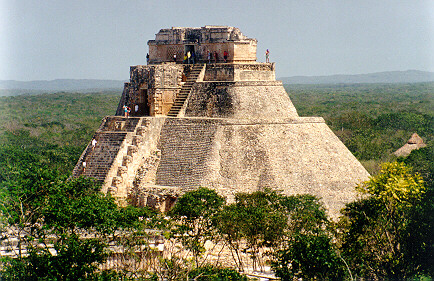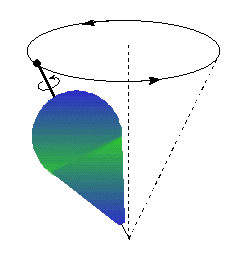http://community-2.w...MayanInitiatic/
Mayan Initiatic Centers/ Hunbatz Men
According to Hunbatz, we are now participating in a new cycle of the Mayan calendars, which synchronize the cycles of time with human beings.
High knowledge is coming, we must prepare to receive it. This is the time when the Maya believe they must work with others to reopen the schools of ancient knowledge--to teach the first stage of understanding. We can learn what each of the sacred centers of the world has to offer us, so that we may become the kinds of human beings needed for this new solar age.
He says that we will have fully entered the New Itza Age by the year 2013. It is time to work into the deepest part of our beings to regain the information we have impressed there--in the spiral of our DNA. Only in this way will millenial information rise into our conscious awareness, reminding us of an ancient time when knowledge was unified and there was no separation between science and religion.
The eyes of modern civilization see only a short span of time. To the European-American culture, five hundred years seems to be a lot of time. But five hundred years is nothing in the eyes of the Maya.
The culture of the Maya teaches the great secrets Mother Nature holds. The Maya understood, as modern science is discovering, that all matter is vibration. Therefore, human life is linked to the heavenly bodies by cosmobiological law. The Maya understood this and made it part of their lives and culture. It is written in time and in the memory of the Indian peoples that our Sun will rise again, that we will be able to reestablish our culture--its arts, sciences, mathematics, and religion. Mayan knowledge will come forward again. It is for this reason that we of the Amerindian communities are once again uniting to reestablish our entire culture. (p.230)
Altogether the Maya have seventeen calendars. One calendar, the Tzolkin, corresponds to the eleven-year sunspot cycle. Haab is a calendar of cultural consummation, based on a cycle of fifty-two years. According to this calendar, every fifty-two years the frequency of human being shifts. Another calendar of twenty-six thousand years, Tzek'er, is based on the Pleiades, a constellation known in Western folklore as the Seven Sisters. According to the Mayan tradition, our Sun is actually part of the Pleiades, and orbits in concert with the other stars of this constellation. The joint rotation of all the stars in the Pleiades, including our Sun, is but a minor motion within the huge, 400-billion-star spiral of our local galaxy, the Milky Way. The Maya have known about the Milky Way for thousands of years, and they make ceremonies to help hold the balance of the galaxy. Hunbatz says that, by contrast, modern science has yet to discover our Sun's connection with the Pleiades. (p.231).
At this point in time, the twenty-six-thousand-year cycle may be coming to an end, or to a peak-a thirteen thousand year midway point. ...We are at a critical turning point, we know the sun is going to help us. This is the cosmic law. Under the terms of cosmic law, a fast car, big money, and a fancy education do nothing for the cosmos. With our technologies we think we are superior, but before the universe we are nothing. We have created in this time a personal culture, instead of a community. (Hunbatz, p. 231)
The calendar of 26,000 years is new for the dominant civilization. It is based on the rotation of the Pleiades, the constellation of which our Sun is part. This calendar portends big changes, a new age. But before this big frequency change is complete, we need to work, to regain the consciousness of the Sun. We need to gain respect for all this cosmic knowledge. If the people don't do that, the change is going to come ayway because no one can stop it. It's not possible to stop. When the people begin to feel the big changes they may be confused. The Sun will wake up everything to life. It shines on all of us, not just some.
Right now, Hunbatz counsels, we need to work with our energy bodies so they will be able to cope with the intensifying energy frequencies in the world, a trend that he says will continue into the foreseeable future. One way to strengthen and stabilize the energy body is through chants and mantras such as those the Maya use. Another important way is through pilgrimmage to holy sites around the Earth.
For the Maya it is the new age--time to give away the knowledge again, to raise the frequency of the global mind. ...One important part of doing this is reopening the Mayan initiatic centers, the temples and pyramids of the Yucatan, Guatemala, and Honduras. (I might add Belize.)
" As foretold in the Mayan sacred calendars, now is the time to reconsecrate the sacred pyramids and temples, and all the other sacred sites of the Americas. In so doing, we can help bring about the respiritualization of the people and the healing of the Earth. Pilgrimmages to the magnetic center of Mayan lands are necessary to assist in the enlightenment of the human race." (Hunbatz, p. 233).
Most of the Elders know about this--that it is time to reopen the old centers, to go there with respect, and to begin to receive information.
In 1988, with the support of other Elders and Shamans, Hunbatz led the first of a series of pilgrimmages to cleanse the temples of the dust of several centuries--to reopen and reconsecrate them so they could be used for sacred work.
Over one hundred men and women of all ages, and many nations, participated in the first historic journey to the Yucatan to begin the process foretold by the Mayan calendars. For the first time in five hundred years, the temples reverberated with the heat, light, and sound of ceremony performed in their grand plazas.
In 1989 they reopened Nah Chan, Etz Nah, Uxmal, Kabah, LolTun, and Chichen Itza. Then in 1990 they reopened Tik'al, Quilghua, and Copan, completing the work of reactivating the Mayan initiatic centers. The pilgrimmages will continue each year until 2013, when the transition to the New Itza Age will be complete.
"We must reopen these places where the knowledge of the great mysteries is deposited, because spirits of the ancient teachers are awaiting the new mind of humanity in order that these sacred places might be revived and indicate the correct path to humanity. The pyramids of Mesoamerica are not tombs. Hunbatz explains.."but places to work with other dimensions of consciousnss, places to understand time. ...We go to the pyramids because the energy flow in there makes for a different vibration. We can use this to help make subtle changes in the frequency of our brain waves. In there we can make the connection with the magnetic forces of the Earth and the cosmos. The geometrical form of the pyramids helps people to transform themselves, to raise their consciousness by raising the frequency of their brain waves. We hope something big is going to happen because of these ceremonies and all the other sacred activities around the world--that the frequency of the modern mind is going to change in a positive way." (Hunbatz Men, 1991, p. 233)
See references. Excerpt from Profiles in Wisdom
editor. Stephen McFadden.(1990) NM:Bear & Co.
Hunbatz Men
Comunidad Indigena Maya
APDO, Postal 7-013
Merida 7
Yucatan, Mexico




































































